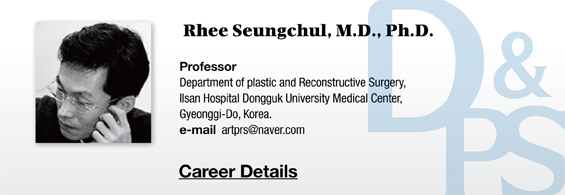
Study on the beauty difference in terms of race and ethnicity
Rhodes4 proposed Asians, Caucasians, Eurasians, and mixed race average composite faces obtained from face morphing. We can distinguish the differences between these average faces of each race and my attractive Korean face. Close observation of Rhodes’s Asian average face revealed that the male face had a slightly longer lower face (51.28%>46.59%) and the female face had longer lower face (47.83%>43.81%) and had more round face because they have more convex shape of lower jaw outline (138.02°~137.55°<141.80°~142.07°). Rhodes’ Asian average face was similar to the average Asian composite face I proposed, which photogrammetric measurement showed statistically showed no difference because most measured values were within 1 standard deviation from my composite face, except for size of palpebral fissure ,
However, the Caucasian and Eurasian faces showed significant photogrammetric differences. , In details, the Caucasian male face had relatively longer face than an Asian attractive face (144.55%>131.13%).They also have longer upper (55.90%>51.94%) and lower face (54.58%>46.59%). Caucasian or Eurasian male’s mouth is larger (40.17%>36.25%) and has narrower lower jaws (136.48°~136.44°>131.96°~131.97°).
The characteristics of Caucasian female face can be summarized as the followings. They has a larger ratio of the length to width of the face (137.96%>134.04%), with a larger lower face (50.00%>43.81%), larger palpebral fissure height (9.40%>7.20%). The ratio of the horizontal length of the lips to the width of the face is larger (37.96%>34.30%) and the width of the lower jaw is larger than the width of the face (bizygomatic distance) (86.57%>81.59%). The lower jaw outline is more rounded (135.72°~134.71°>141.80°~142.07°).
[Advertisement] Ultra Skin/Pastelle – Manufacturer: WONTECH(www.wtlaser.com)
On the other hand, a Eurasian male face had relatively longer length of the face in respect to the width (139.02%>131.13%), with larger upper (54.63%>51.94%) and lower face (51.72%>46.59%). Their forehead was narrower (28.42 < 31.17 %) and the vertical length of the eye was small (5.29 %< 6.21%).Meanwhile, the female Eurasian face had a longer face (137.38%>134.04%) and they have especially longer lower face (50.00%>43.81%) in respect to average attractive Asian faces. Moreover, they have much larger mouth, which exceeding 3 standard deviation (41.12%>34.30%). Lower jaw of Eurasian female composite face was more rounded (135.72°~137.78°>141.80°~142.07°) than that of average attractive Asian female.
From this comparison, it was evident that the average face was not attractive one. It was proved by the statistical analysis on the photogrammetric measurement between the average faces and attractive faces of different races.

Image 1. Average composite faces from different ethnic races
<Image 1>6 shows face morphing images of an average female attractive face of the black, Caucasian, Chinese, Japanese and Korean race from my study published in Aesthetic Plastic Surgery in October 2010. This study was a follow-up of my previous study “The average Korean attractive face”7 published in Aesthetic Plastic Surgery. I used Average facial morphing method to create composite images of female celebrities thought attractive in each race. Thirteen black, 16 Caucasian, 20 Chinese and 14 Japanese female celebrities were included. I proposed that traditional concepts of beauty must be changed and attractive faces of each race have different characteristics.
Need for different plastic surgical approach in each race and ethnicity
The average attractive composite faces of each race have following implications.
- Traditional aesthetic theories propose that an average face is attractive, however, the most beautiful face is not the average of ordinary faces but that of attractive faces. Therefore, better aesthetic procedures are not possible with average theory or by using old cephalometric analysis or norms. In other words, new cephalometric data of attractive faces is needed to establish new beauty standards for cosmetic surgery.
- The standards of beauty changed with time and not fixed one. They will continue to change. Efforts have been made to analyze the face based on the golden facial mask or golden ratio. However, these concepts are limited and inaccurate. Scholars have wrongfully tried to unify standardize beauty into one conception across different races without considering unique characteristics of each race and ethnicity.
- The average attractive face of each race that I have presented above cannot be regarded as universal and ideal standards of beauty for each race and ethnicity, however, they will give some help to understand the different beauty preferences among different ethnic races. Understanding changing standards of beauty and characteristics particular to different races and ethnicities, rather than applying uniform standards to all races is needed for a more streamlined approach in plastic surgery. Relative and subjective standards according to patients should be given more weight when setting goals for aesthetic procedures.
- Comparing with the average face of each race, the attractive Japanese female face is longer than the average Japanese face with superolateral position of the palpebral fissure. The chin is narrower and cheeks are plump. The Chinese face has narrower cheekbones and chin compared to the average Asian face. The Caucasian face showed slightly masculine features with a smaller vertical length of the eye compared to the average Caucasian face. The chin is more angular, the front cheekbones protrude more and lips are thicker and fuller. The African face is smaller than the average black face, with slanted eyes, relatively thin lips, narrow nose and chin.
- These composite images of an attractive face in each race show characteristics unique to the race and statistically significant differences from average faces of each race. This indicates that an attractive face has features that are different from an average face of that race. These differences should be given consideration in cosmetic surgery.
The next article will discuss differences in beauty conception according to gender and generations.
References
- Stephen R, Marquardt, Marquardt beauty analysis California, Available at: http:// www.beautyanalysis.com/, Accessed May 2005.
- Le TT, Farkas LG, Ngim RCK, Levin LS, Forrest CR: Proportionality in Asian and North Caucasian faces using neoclassical facial canons as criteria. Aesth Plast Surg 26: 64, 2002
- Rhodes G, Yoshikawa S, Clark A, Lee K, McKay R et al., Attractiveness of facial averageness and symmetry in non-western cultures: in search of biologically based standards of beauty, Perception, 30(5), 615-625,2002.
- Rhodes G, Lee K, Palermo R, Weiss M, Yoshikawa S et al., Attractiveness of own-race, other-race and mixed race faces, Perception, 34(3):319-340,2005.
- Chung CS, Psychometric engines for synthesizing facial expressions and classifying facial types, presented at 1st Autumn Congress of the Korean Face Academy, at The Kim Goo Museum and Library, in Seoul, Korea, Oct. 16, 2005.
- Rhee SC, Lee SH. Attractive composite faces of different races. Aesthetic Plast Surg. 34(6):800-1. 2010.
- Rhee SC, The average Korean attractive face. Aesthetic Plast Surg. 30(6):729-30.206.
-To be continued-




















